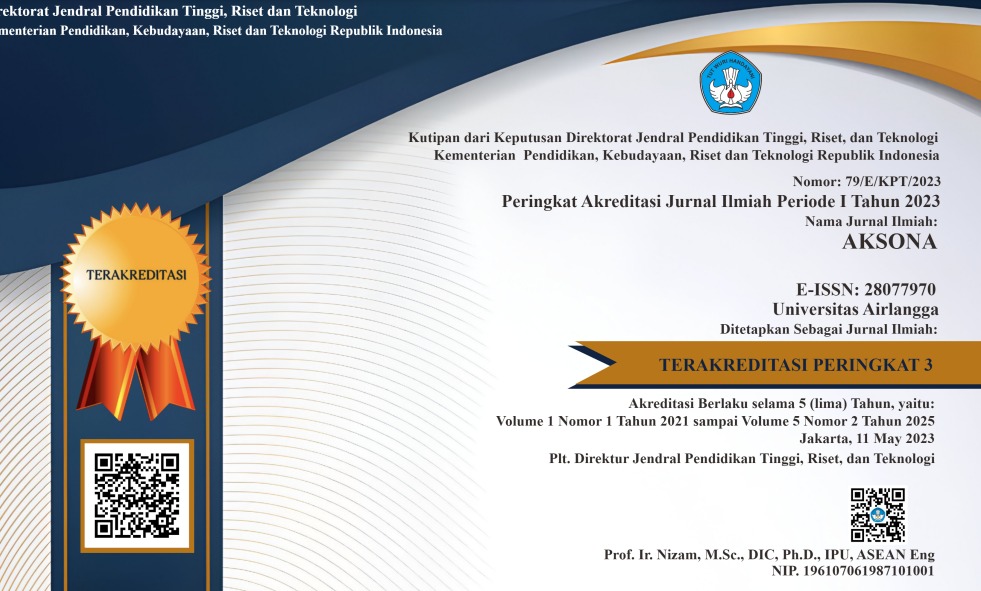Profiles of Patients with Low Back Pain Caused by Disc Herniation in the Neurology Outpatient Clinic of Dr. Soetomo General Academic Hospital Surabaya during the Period of 2021
Downloads
Highlight:
- The degenerative process plays a dual role, both protecting from and causing disc herniation.
- Men have a quicker degeneration rate at a younger age, while women have a quicker rate at an older age.
- Occupational factors such as physical workload, repetition, bending, and sitting periods all contribute to disc herniation.
ABSTRACT
Introduction: Low back pain (LBP) refers to a sensation of pain or discomfort occurring in the region between the lowest costal and gluteal crease, with or without leg pain. Damage to the annulus fibrosus causes disc herniation, allowing the nucleus pulposus to herniate into the spinal canal. In less than 5% of cases, LBP is caused by disc herniation. Objective: This study examined the profiles of individuals with herniated LBP discs and related factors at Dr. Soetomo General Academic Hospital Surabaya. Methods: The study was conducted at Dr. Soetomo General Academic Hospital Surabaya using secondary data from medical records, which was then analyzed using descriptive statistics. Results: Fifty-eight LBP patients with herniated discs were enrolled in this study. The patient sample ranged from 23 to 74 years old, with a mean of 47,98±14,92. The majority of patients (29.3%) were 31–40 years old. Male and female prevalence rates were the same. Employees have the highest percentage of any occupation group, with 56.9%. Conclusion: Some of the findings clarify previous studies. Age, gender, and occupation were all linked to the occurrence of either LBP or disc herniation. However, our data cannot indicate whether or not these factors contribute to the occurrence of LBP and disc herniation. Therefore, more research is required to understand these factors and their relation to disc herniation and LBP.
World Health Organization. International classification of diseases 11th revision (ICD-11). 2024. Available at: https://www.who.int/standards/classifications/classification-of-diseases
Maher C, Underwood M, Buchbinder R. Non-specific low back pain. Lancet. 2017; 389(10070):736–47. doi: 10.1016/S0140-6736(16)30970-9
Knezevic NN, Candido KD, Vlaeyen JWS, Van Zundert J, Cohen SP. Low back pain. Lancet. 2021; 398(10294):78–92. doi: 10.1016/S0140-6736(21)00733-9
Manusov EG. Evaluation and diagnosis of low back pain. Prim Care Clin Off Pract. 2012; 39(3):471–9. doi: 10.1016/j.pop.2012.06.003
Dydyk AM, Massa RN, Mesfin FB. Disc herniation. In: StatPearls. Treasure Island (FL): StatPearls Publishing; 2023. [Book]
Wu A, March L, Zheng X, Huang J, Wang X, Zhao J, et al. Global low back pain prevalence and years lived with disability from 1990 to 2017: Estimates from the Global Burden of Disease Study 2017. Ann Transl Med. 2020; 8(6):299. doi: 10.21037/atm.2020.02.175
Ramdas J, Jella V. Prevalence and risk factors of low back pain. Int J Adv Med. 2018; 5(5):1120–3. doi: 10.18203/2349-3933.ijam20183413
Zafar F, Qasim YF, Farooq MU, Shamael I, Khan IU, Khan DH. The frequency of different risk factors for lower back pain in a tertiary care hospital. Cureus. 2018; 10(8):e3183. doi: 10.7759/cureus.3183
Goin ZZ, Pontoh LM, Umasangadji H. Karakteristik pasien nyeri punggung bawah di poliklinik rehabilitasi medik Rumah Sakit Daerah Kota Tidore Kepulauan periode Januari-Juni 2019. Kieraha Med J. 2019; 1(1):44–53. [Journal]
Wong AY, Karppinen J, Samartzis D. Low back pain in older adults: risk factors, management options and future directions. Scoliosis Spinal Disord. 2017; 12(1):14. doi: 10.1186/s13013-017-0121-3
Govindu NK, Babski-Reeves K. Effects of personal, psychosocial and occupational factors on low back pain severity in workers. Int J Ind Ergon. 2014; 44(2):335–41. doi: 10.1016/j.ergon.2012.11.007
Yang H, Haldeman S, Lu M-L, Baker D. Low back pain prevalence and related workplace psychosocial risk factors: A study using data from the 2010 National Health Interveiw Survey. J Manipulative Physiol Ther. 2016;39(7):459–72. doi: 10.1016/j.jmpt.2016.07.004
Ishimoto Y, Cooper C, Ntani G, Yamada H, Hashizume H, Nagata K, et al. Factory and construction work is associated with an increased risk of severe lumbar spinal stenosis on MRI: A case control analysis within the wakayama spine study. Am J Ind Med. 2019; 62(5):430–8. doi: 10.1002/ajim.22957
Rachmawati Y, Hidayati HB. The role of substance P in chronic low back pain (CLBP). J Islam Pharm. 2019; 4(2):9–14. doi: 10.18860/jip.v4i2.8613
Zielinska N, Podgórski M, Haładaj R, Polguj M, Olewnik Ł. Risk facotrs of intervertebral disc pathology—A point of view formerly and today—A review. J Clin Med. 2021; 10(3):409. doi: 10.3390/jcm10030409
Schwarzer AC, Aprill CN, Derby R, Fortin J, Kine G, Bogduk N. The prevalence and clinical features of internal disc disruption inpatients With chronic low back pain. Spine (Phila Pa 1976). 1995; 20(17):1878–83. [Journal]
Uzlifatin Y, Arfianti L, Wardhani IL, Hidayati HB, Melaniani S. Effect of transcutaneous auricular vagus nerve stimulation addition on disability in chronic low back pain patients: A randomized controlled study. Anaesthesia, Pain Intensive Care. 2023; 27(1):73–81. doi: 10.35975/apic.v27i1.2084
Amin RM, Andrade NS, Neuman BJ. Lumbar disc herniation. Curr Rev Musculoskelet Med. 2017; 10(4):507–16. doi: 10.1007/s12178-017-9441-4
Fjeld OR, Grøvle L, Helgeland J, Småstuen MC, Solberg TK, Zwart J-A, et al. Complications, reoperations, readmissions, and length of hospital stay in 34 639 surgical cases of lumbar disc herniation. Bone Joint J. 2019; 101-B(4):470–7. doi: 10.1302/0301-620X.101B4.BJJ-2018-1184.R1
World Health Organization. Low back pain. 2023. Available at: https://www.who.int/news-room/fact-sheets/detail/low-back-pain
Cahya H IPI, Asmara AGY. Prevalensi nyeri punggung bawah pada tahun 2014-2015 di RSUP Sanglah Denpasar. J Med Udayana. 2020;9(6):35–9. doi: 10.24843/MU.2020.V09.i6.P08
Gibson SJ, Helme RD. Age-related differences in pain perception and report. Clin Geriatr Med. 2001; 17(3):433–56. doi: 10.1016/S0749-0690(05)70079-3
Azemi ES, Kola S, Kola I, Tanka M, Bilaj F, Abazaj E. Lumbar disk herniation: A clinical epidemiological and radiological evaluation. Open Access Maced J Med Sci. 2022; 10(B):1588–94. doi: 0000-0003-2386-4605
Qi L, Luo L, Meng X, Zhang J, Yu T, Nie X, et al. Risk factors for lumbar disc herniation in adolescents and young adults: A case–control study. Front Surg. 2023; 9:1009568. doi: 10.3389/fsurg.2022.1009568/full
Schroeder GD, Guyre CA, Vaccaro AR. The epidemiology and pathophysiology of lumbar disc herniations. Semin Spine Surg. 2016; 28(1):2–7. doi: 10.1053/j.semss.2015.08.003
Ovcharov ME, Mladenovski MN, Mladenovski IN, Valkov I V., Vasilkova SB. Lumbar disc herniation in children and elderly patients. Folia Med (Plovdiv). 2023; 65(4):631–7. doi: 10.3897/folmed.65.e97233
Cai Z, Ma D, Li F, Chen R, Liu Z, Zhang Z, et al. Trend of the incidence of lumbar disc herniation: Decreasing with aging in the elderly. Clin Interv Aging. 2013; 8:1047–50. doi: 10.2147/CIA/.S49698
Wáng YXJ, Wáng J-Q, Káplár Z. Increased low back pain prevalence in females than in males after menopause age: Evidences based on synthetic literature review. Quant Imaging Med Surg. 2016; 6(2):199–206. doi: 10.21037/qims.2016.04.06
Heliövaara M. Occupation and risk of herniated lumbar intervertebral disc or sciatica leading to hospitalization. J Chronic Dis. 1987; 40(3):259–64. doi: 10.1016/0021-9681(87)90162-7
Jia N, Zhang M, Zhang H, Ling R, Liu Y, Li G, et al. Prevalence and risk factors analysis for low back pain among occupational groups in key industries of China. BMC Public Health. 2022; 22(1):1493. doi: 10.1186/s12889-022-13730-8
Billy GG, Lemieux SK, Chow MX. Lumbar disc changes associated with prolonged sitting. PM&R. 2014; 6(9):790–5. doi: 10.1016/j.pmrj.2014.02.014
Copyright (c) 2024 Bani Agindra, Hanik Badriyah Hidayati, Lukas Widhiyanto, Lilik Herawati

This work is licensed under a Creative Commons Attribution-ShareAlike 4.0 International License.





















